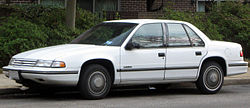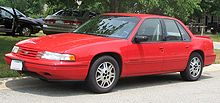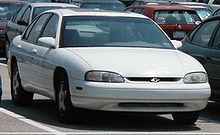- Chevrolet Lumina
-
This article is about the sedan and coupe. For the minivan, see Chevrolet Lumina APV.This article is about the North American, Middle Eastern, and South African versions. For the Chinese-made version sold in the Philippines, see Buick Regal.
Chevrolet Lumina 
Manufacturer General Motors Production 1990–2001 (North America)
1998–present (Middle East, South Africa)Predecessor Chevrolet Celebrity (sedan)
Chevrolet Monte Carlo (coupe)Successor Chevrolet Impala (sedan)
Chevrolet Monte Carlo (coupe)Class Mid-size Related Chevrolet Monte Carlo The North American Chevrolet Lumina sedan , coupe and minivan were first introduced in 1989 for the 1990 model year as a new range of vehicles from the Chevrolet brand of General Motors to replace the Chevrolet Camaro, Chevrolet Celebrity sedan, and the Monte Carlo coupe. The Lumina was an answer from General Motors to the Ford Taurus. All Luminas were built at the Oshawa Car Assembly plant, in Ontario, Canada. The Chevrolet Lumina had the longest length from any other W-body car at the time.
Consumers were ultimately confused by having two different vehicles (the Lumina sedan and the Lumina APV minivan) share the same name, and the concept was eventually dropped when the Lumina APV was replaced by the Chevrolet Venture in 1997.
The namebadge is also used on a variety of vehicles in the Holden Commodore family sold in the Middle East and South Africa.
Contents
First generation (1990–1994)
First Generation 
Also called Chevrolet Z34 Production 1990–1994 Assembly Oshawa, Ontario, Canada Body style 2-door coupe
4-door sedanLayout FF layout Platform W-body Engine 2.5 L Iron Duke I4
3.1 L LH0 V6
3.4 L LQ1 V6Transmission 5-speed manual
3-speed 3T40 automatic
4-speed 4T60 automatic
4-speed 4T60-E automaticWheelbase 107.5 in (2,731 mm) Length 1990 Coupe: 198.4 in (5,039 mm)
1990 Sedan: 197.6 in (5,019 mm)
1991–94 Coupe & 1993–94 Sedan: 198.3 in (5,037 mm)
1991–92 Sedan & Z34 Sedan: 199.3 in (5,062 mm)Width Coupe & Z34 Sedan: 71.7 in (1,821 mm)
Sedan: 71.0 in (1,803 mm)Height Coupe & Z34 Sedan: 53.3 in (1,354 mm)
Sedan: 53.6 in (1,361 mm)Curb weight 3496 lb (1586 kg) Related Buick Regal
Oldsmobile Cutlass Supreme
Pontiac Grand PrixThe North American Chevrolet Lumina was based on the mid-size GM W platform, which was shared with the Pontiac Grand Prix, Oldsmobile Cutlass Supreme, Oldsmobile Intrigue, Buick Regal and Buick Century (after 1996). Although the Lumina became a popular seller, GM was widely criticized in the motoring press for being late to the game in introducing a direct aero-designed competitor to the Ford Taurus. The Chevrolet Lumina's first generation ended production in 1994, making this the shortest-lived generation of the first-generation GM W-body cars.
In 1989, the Lumina became the nameplate under which Chevrolets were raced in NASCAR, more than a year before the model was available to the public. Irate fans bombarded NASCAR with letters protesting the unfairness of Chevrolet being allowed to race an aluminum car.[citation needed]
In 1987 however, GM was experimenting with a high end performance version above the Z34 to continue where the Z34 left off. The experimental "Z50" version as it was dubbed featured all-wheel-drive and an all aluminum 5.0 L 305ci LT1-style V8 which had 285 hp (213 kW) and 280 ft·lbf (380 N·m) of torque. It never made it to production. The whereabouts of these test-cars remains unknown.[citation needed]
Specifications
- Front Head Room 39.9 in.
- Front Hip Room 51.9 in.
- Front Shoulder 59.9
- Front Leg 49.9
- Fuel Tank 16.5 gallons
Engines
- 1990–1992 2.5 L (151 in³) Iron Duke I4
- 1993–1994 2.2 L (134 in³) I4
- 1990–1994 3.1 L (191 in³) LHO V6
- 1991–1994 3.4 L DOHC (207 in³) LQ1 V6
Lumina Z34
Main article: Lumina Z34The high performance version of the Lumina was the Lumina Z34 (coupe) and Euro 3.4 (sedan). Along with a performance suspension package, it was fitted with the 3.4 L DOHC LQ1 V6, putting out 210 hp at 5200 rpm and 215 lb·ftf (292 N·m) of torque at 4400 rpm. The LQ1 could be had with either a four speed automatic or a bespoke five speed manual, the Getrag 284. Unique cosmetic changes include a factory spoiler and body moldings, a louvered hood, and a unique steering wheel. The grille was also replaced with a body-colored panel with a small outlet, reminiscent of the Ford Taurus SHO. Performance figures are quite impressive for a front wheel drive V6 car, with a 0-60(mph) time of 7.5 seconds, 1/4 mile (~400 m) time of 15.5 seconds and a (limited) top speed of 130 mph (209.21 km/h).
Production Numbers
Production
Year Total Sedans Total Coupes Sedan LQ1 Coupe LQ1 1990 278,311 45,783 N/A N/A 1991 157,782 34,495 N/A 8,936 1992 188,557 33,490 5,623 13,016 1993 200,842 29,916 3,489 12,323 1994 75,753 10,866 1,234 4,478 Total production 901,245 154,500 Second generation (1995–2001)
Second Generation: Production 1995–2001 Body style 4-door sedan Layout FF layout Platform W-body 1.5 Gen Engine 3.1 L L82 V6
3.1 L LG8 V6
3.4 L LQ1 V6
3.8 L L36 V6Transmission 4-speed 4T60-E automatic
4-speed 4T65-E automaticLength 200.9 in (5,103 mm) Width 72.5 in (1,842 mm) Height 1995–98: 55.2 in (1,402 mm)
1999–2001: 54.8 in (1,392 mm)Related Chevrolet Monte Carlo The Lumina received new sheetmetal and an updated interior for 1995, with the Monte Carlo name being resurrected for the 2-door version previously sold as the Lumina coupe, and slightly larger. Unlike its other W platform sisters, it used the same chassis as the '90-94 model. The Euro trim level was now named LS. The LH0 V6 was dropped in favor of the L82 V6, also known as the 3100 SFI, which made 20 more hp out of the same displacement thanks to a revised intake manifold and cylinder heads. This Lumina was also sold with police (code 9C3) and taxi packages, due to the Chevrolet Caprice being discontinued after the 1996 model year.
Initial trim levels consisted of base and LS. Options included an electric sunroof, leather bucket seats, power windows, power driver seat, and AM/FM stereo with CD player.
The LTZ trim was introduced in 1997 to soften the blow from the discontinued Impala SS and Caprice. Its standard features included 16" brushed aluminum wheels, blackwall radial sport tires, sport tuned suspension, a 3.1 L V6 rated at 160 hp (120 kW) and 185 ft·lbf (251 N·m) or an optional 3.4 L V6 rated at 215 hp (160 kW) and 220 ft·lbf (300 N·m) of torque, a rear spoiler, restyled front and rear body clips (resembling the Monte Carlo Z34), a tachometer, and a floor-mounted shifter.
In 1998 the 3.4 L V6 was replaced by the 3800 Series II which made 200 hp (150 kW) and 225 ft·lbf (305 N·m) torque. Despite its increased torque, the 3.8 liter LTZ demonstrated slightly worse performance due to its lowered horsepower, with 0-60 mph (0–100 km/h) times of 7.5 seconds (as opposed to 7.2 for the LQ1) and 1/4 mile (~400 m) times of 15.7 seconds (as opposed to 15.5 for the LQ1). The car has a naturally-limited top speed of 107 mph (172 km/h) and the rev limiter kicks in at 5800 rpm.
Also in 1998, the Lumina received second generation airbags. The front-wheel drive Chevrolet Impala was introduced as a replacement for the Lumina in 2000, although GM did produce 2001 model year Luminas to be exclusively sold for rental fleets. Retail sales of the Lumina ended in Canada in 1999, with the United States following suit a year later. Fleet production ended on April 26, 2001. In some Asian countries, the Lumina continued as a rebadged Buick Century/Regal.
Specification levels
Throughout its lifecycle, the second generation Lumina was available in three trim levels:
Base (1995–2001): The most popular Lumina, the base model came well equipped for its price point. It had standard six-passenger seating, power locks, tilt steering wheel, dual airbags, and air conditioning. Base models were equipped with fifteen-inch steel wheels with wheel covers.
LS (1995–1999): One step above the base, LS models offered aluminum wheels, optional dual zone temperature controls, power windows (optional on Base), tachometer, higher-end stereo with GM's Delcolock, anti-lock brakes, remote keyless entry system, upgraded seats, and an optional 3.4 L DOHC engine.
LTZ (1997–1999): The top of the line Lumina which included alloy wheels, a choice of the 3.1 L V6 engine, 3.4L DOHC engine or 3.8 L V6 engine (1998-1999 only), power driver seat, dual zone climate control and leather with the option for deluxe cloth. A center console was standard on LTZ (optional on LS). To differentiate itself aesthetically from the lesser models, it received the front end and trunk lid from the Fifth Generation Chevrolet Monte Carlo.
Engines
- 1995–1999 3.1 L (191 in³) L82 V6
- 1995–1997 3.4 L DOHC(207 in³) LQ1 V6
- 1997–1999 3.8 L (231 in³) L36 V6
- 2000–2001 3.1 L (191 in³) LG8 V6
Production
Year Units 1995 264,688 1995 LQ1 15,988 1996 224,553 1996 LQ1 2,054 1997 234,626 1998 208,627 1998 L36 16,679 1999 139,098 1999 L36 13,869 2000 37,493 2001 42,803 Total production 1,151,888 IIHS Crash Test Results
The IIHS tested the 1995 model and gave it a Good rating on all six marks in the frontal offset crash test, as the dummy survives the crash with no injuries.
Third generation (1998–2006)
Main article: Holden CommodoreSince 1998, the Holden Commodore has been sold as the Chevrolet Lumina in the Middle East and South Africa, and previously in South East Asia. A coupe version based on the Holden Monaro was also sold in the Middle East as the Chevrolet Lumina Coupe.
Fourth generation (2006–present)
Main article: Holden CommodoreHolden released the all new VE Holden Commodore in Australia in 2006. In 2007 it was rebadged and exported from Australia as the newest generation of the Chevrolet Lumina. It is currently being sold in the Middle East and South Africa. The Holden Ute is in South Africa and Middle East available as the Lumina Ute
References
- ^ The Encyclopedia of American Cars, 2006 Edition
External links
« previous – Chevrolet, a division of General Motors, road car timeline, United States market, 1980s–present Type 1980s 1990s 2000s 2010s 0 1 2 3 4 5 6 7 8 9 0 1 2 3 4 5 6 7 8 9 0 1 2 3 4 5 6 7 8 9 0 1 2 Subcompact Sprint Geo Metro Chevette Aveo Sonic Spectrum Monza Nova Compact Prizm Volt Cavalier Cavalier Cavalier HHR Citation Cobalt Cruze Mid-size Malibu Corsica / Beretta Malibu Malibu Malibu Celebrity Lumina Lumina Full-size Impala Impala SS Impala Impala Caprice Caprice Caprice Personal Monte Carlo Monte Carlo Monte Carlo Monte Carlo Sports Camaro Camaro Camaro Camaro Corvette Corvette Corvette Corvette Categories:- Chevrolet vehicles
- Front wheel drive vehicles
- Mid-size cars
- Sedans
- Coupes
- Vehicles introduced in 1989
- Goods manufactured in Canada
Wikimedia Foundation. 2010.







